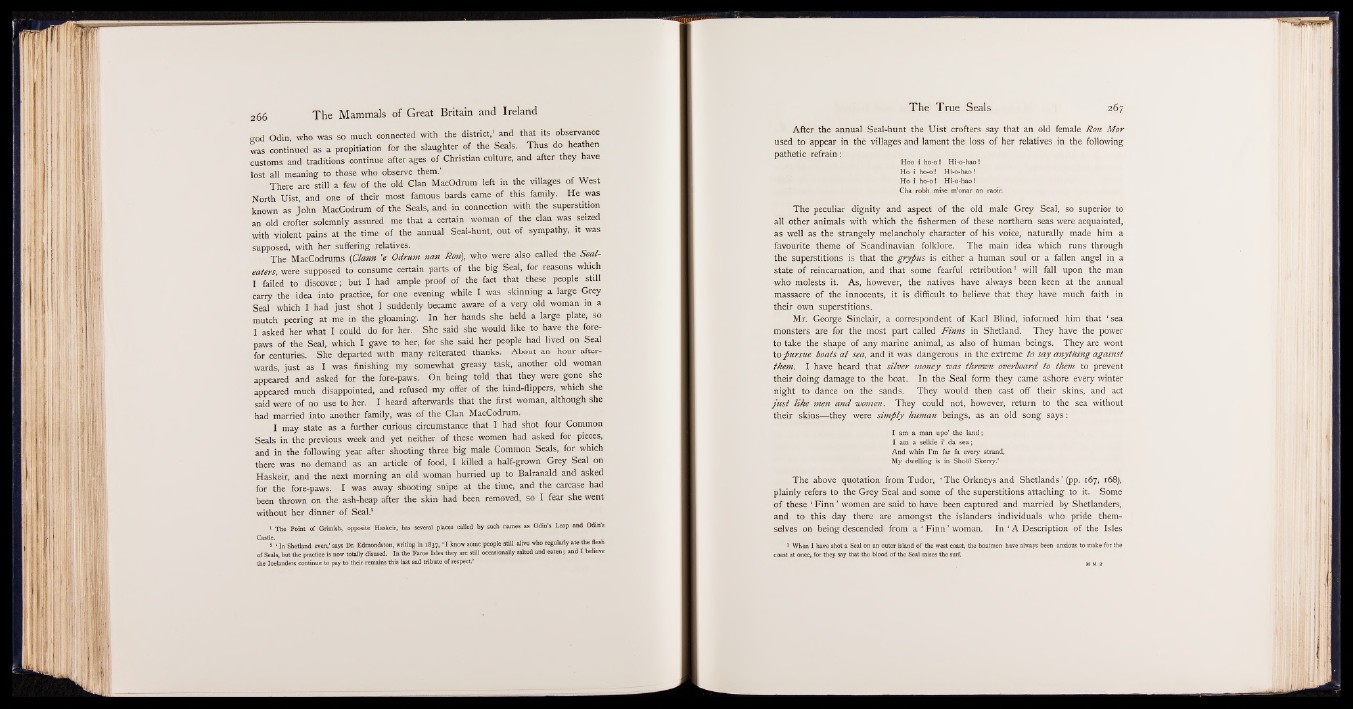
god Odin, who was so much connected with the district,1 and that its observance
was continued as a propitiation for the slaughter of the Seals. Thus do heathen
customs and traditions continue after ages of Christian culture, and after they have
lost all meaning to those who observe them.
There are still a few of the old Clan MacOdrum left in the villages of West
North Uist, and one of their most famous bards came of this family. He was
known as John MacCodrum of the Seals, and in connection with the superstition
an old crofter solemnly assured me that a certain woman of the clan was seized
with violent pains at the time of the annual Seal-hunt, out of sympathy, it was
supposed, with her suffering relatives.
The MacCodrums (Clam 'e Odrum nan Ron), who were also called the Seal-
eaters, were supposed to consume certain parts of the big Seal, for reasons which
I failed to discover; but I had ample proof of the fact that these people Still
carry the idea into practice, for one evening while I was skinning a large Grey
Seal which I had just shot I suddenly became aware of a very old Woman in a
mutch peering at me in the gloaming. In her hands she held a large plate, so
I asked her what I could do for her. She said she would like to have the forepaws
of the Seal, which I gave to her, for she said her people had lived on Seal
for centuries. She departed with manyi reiterated thanks. About an hour afterwards,
just as I was finishing my somewhat greasy task, another old woman
appeared and asked for the fore-paws. On being told that they were, gone she
appeared much disappointed, and refused my offer of the hind-flippers, which she
said were of no use to her. I heard afterwards that the first woman, although she
had married into another family, was of the Clan MacCodrum.
I may state as a further curious circumstance that I had shot four Common
Seals in the previous week and yet neither of these women had asked for pieces,
and in the following year after shooting three big male Common Seals, for which
there was no demand as an article of food, I killed a half-grown Grey Seal on
Haskeir, and the next morning an old woman hurried up to Balranald and asked
for the fore-paws. I was away shooting snipe at the time, and the carcase had
been thrown on the ash-heap after the skin had been removed, so' l fear she went
without her dinner of Seal.®
1 The Point of Grimish, opposite Haskeir, has several places called by such names as Odin’s Leap and Odins
Castle.
* ‘ In swiand even,’ says Dr. Edmondston, writing in 1837, ‘ I know some people still alive who regularly ate the flesh
of S»aJ<=, but the practice is now totally disused. In the Faroe Isles they are still occasionally salted and eaten; and I believe
the Icelanders continue to pay to their remains this last sad tribute of respect.’
After the annual Seal-hunt the Uist crofters say that an old female Ron Mor
used to appear in the villages and lament the loss of her relatives in the following
pathetic refrain:
Hoo i ho-o! Hi-o-hao!
Ho i ho-o! Hi-o-hao!
Ho i ho-o! Hi-o-hao!
Cha robh mise m’onar an raoir.
The peculiar dignity and aspect of the old male Grey Seal, so superior to
all other animals with which the fishermen of these northern seas were acquainted,
as well as the strangely melancholy character of his voice, naturally made him a
favourite theme of Scandinavian folklore. The main idea which runs through
the superstitions is that the grypus is either a human soul or a fallen angel in a
state of reincarnation, and that some fearful retribution1 will fall upon the man
who molests it. As, however, the natives have always been keen at the annual
massacre of the innocents, it is difficult to believe that they have much faith in
their own superstitions.
Mr. George Sinclair, a correspondent of Karl Blind, informed him that ‘ sea
monsters are for the most part called Finns in Shetland. They have the power
to take the shape of any marine animal, as also of human beings. They are wont
to pursue boats at sea, and it was dangerous in the extreme to say anything against
them. I have heard that silver money was thrown overboard to them to prevent
their doing damage to the boat. In the Seal form they came ashore every winter
night to dance on the sands. They would then cast off their skins, and act
ju s t like men and women. They could not, however, return to the sea without
their skins—-they were simply human beings, as an old song says:
I am a man upo’ the land;
I am a selkie i’ da sea;
And whin I’m far fa every strand,
My dwelling is in Shool Skerry.’
The above quotation from Tudor, ‘ The Orkneys and Shetlands ’ (pp. 167, 168),
plainly refers to the Grey Seal and some of the superstitions attaching to it. Some
of these ‘ Finn ’ women are said to have been captured and married by Shetlanders,
and to this day there are amongst the islanders individuals who pride themselves
on being descended from a ‘ Finn ’ woman. In ‘ A Description of the Isles
1 When I have shot a Seal on an outer island of the west coast, the boatmen have always been anxious to make for the
coast at once, for they say that the blood of the Seal raises the surf.